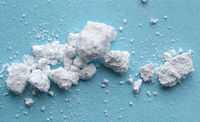Strontium oxide
| Strontium oxide[1] | ||
|---|---|---|
 | ||
 | ||
| IUPAC name Strontium oxide | ||
| Other names Strontia | ||
| Identifiers | ||
| CAS number | 1314-11-0 | |
| PubChem | 73975 | |
| EC number | 215-219-9 | |
| Jmol-3D images | {{#if:[O-2].[Sr+2]|Image 1 | |
| ||
| ||
| Properties | ||
| Molecular formula | SrO | |
| Molar mass | 103.619 g/mol | |
| Appearance | colorless cubic crystals | |
| Density | 4.70 g/cm3 | |
| Melting point | 2,531 °C; 4,588 °F; 2,804 K | |
| Boiling point | 3,200 °C; 5,790 °F; 3,470 K (decomp.) | |
| Solubility in water | reacts, forms Sr(OH)2 | |
| Solubility | miscible with potassium hydroxide slightly soluble in alcohol insoluble in acetone and ether | |
| Refractive index (nD) | 1.810 [2] | |
| Structure | ||
| Crystal structure | Halite (cubic), cF8 | |
| Space group | Fm3m, No. 225 | |
| Coordination geometry |
Octahedral (Sr2+); octahedral (O2–) | |
| Thermochemistry | ||
| Std enthalpy of formation ΔfH |
-592.0 kJ·mol−1 | |
| Standard molar entropy S |
57.2 J·mol−1·K−1 | |
| Specific heat capacity, C | 44.3 J·mol−1·K−1 | |
| Hazards | ||
| EU Index | Not listed | |
| Flash point | Non-flammable | |
| Related compounds | ||
| Other anions | Strontium sulfide | |
| Other cations | Beryllium oxide Magnesium oxide Calcium oxide Barium oxide | |
| Related compounds | Strontium hydroxide | |
| Except where noted otherwise, data are given for materials in their standard state (at 25 °C (77 °F), 100 kPa) | ||
| Infobox references | ||
Strontium oxide or strontia, SrO, is formed when strontium reacts with oxygen. Burning strontium in air results in a mixture of strontium oxide and strontium nitride. It also forms from the decomposition of strontium carbonate SrCO3. It is a strongly basic oxide.
Uses
About 8% by weight of television picture tube glass is strontium oxide, which has been the major use of strontium since 1970.[3] Color televisions and other devices containing color cathode ray tubes sold in the United States are required by law to use strontium in the faceplate to block X-ray emission (these X-ray emitting TV's are no longer in production). Lead oxide can be used in the neck and funnel, but causes discoloration when used in the faceplate.[4]
Reactions
Elemental strontium is formed when strontium oxide is heated with aluminium in a vacuum.[1]
References
- ↑ 1.0 1.1 Lide, David R. (1998). Handbook of Chemistry and Physics (87 ed.). Boca Raton, FL: CRC Press. pp. 4–87. ISBN 0-8493-0594-2.
- ↑ Pradyot Patnaik. Handbook of Inorganic Chemicals. McGraw-Hill, 2002, ISBN 0-07-049439-8
- ↑ Ober, Joyce A.; Polyak, Désirée E. "Mineral Yearbook 2007:Strontium". United States Geological Survey. Retrieved 2009-09-14.
- ↑ Méar, F; Yot, P; Cambon, M; Ribes, M (2006). "The characterization of waste cathode-ray tube glass.". Waste management 26 (12): 1468–76. doi:10.1016/j.wasman.2005.11.017. ISSN 0956-053X. PMID 16427267.
External links
| |||||